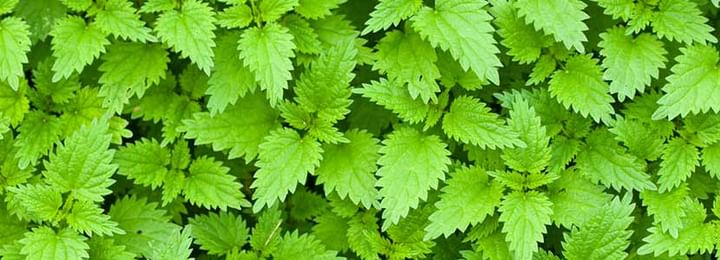Benefits of Nettle Leaf And Its Side Effects
Last Updated: Jan 20, 2025
Even though nettle is often avoided and deemed as a useless plant, it has been the subject of numerous studies that prove its worth. Its scientific name is urtica dioica. Nettle contains impressive amounts of vitamins and minerals. Some of the vitamins it contains include vitamins A, C, D, E, and K. It also contains amino acids and antioxidants, which help in fighting off free radicals. Studies have shown stinging nettle has antioxidant, antimicrobial, anti-ulcer, astringent and analgesic capabilities.
Nettle Leaf
Nettle is a diuretic, which means that it helps in flushing out harmful chemicals and excess liquids from the body. Herbalists have prescribed the use of nettle in treating urinary tract infections as well, because of its ability to cleanse and dispel toxins. This herb has also been called a “spring tonic,” which is a substance intended to cleanse the body after winter.
Nutritional Value of Nettle Leaf
Some of the vitamins it contains include vitamins A, C, D, E, and K. It also contains amino acids and antioxidants, which help in fighting off free radicals. Studies have shown stinging nettle has antioxidant, antimicrobial, anti-ulcer, astringent and analgesic capabilities.
Nutritional facts Per 1-cup
Vitamins and Minerals
Health Benefits of Nettle Leaf
Reduces stress and tension
Nettle contains high amounts of iron and vitamin C, which improves the body’s absorption of iron, which helps in alleviating anemia and fatigue. This herb also contains a considerable amount of potassium, a mineral that reduces tension in arteries and blood vessels, thus, lowering risks of heart attacks and strokes.
Used as an antioxidant
The antioxidant properties of the nettle plant have been observed to help minimize inflammation. It can be used topically to help relieve joint pain as well. It is used for osteoarthritis.
Helps against allergies
The ingestion of nettle tea is known to help dampen the body’s response to allergens by binding with the body’s histamine receptors. It can be used to help in the prevention of rhinitis, or the inflammation of the mucous membrane in the nose. Nettle also helps people suffering from asthma.
Improves prostate health
Studies also suggest that it may have a positive effect on the prostate and may aid in the prevention of benign prostate hyperplasia, which is the noncancerous enlargement of the prostate gland. This herb limits and regulates the amount of testosterone produced by the body. It’s usually used in combination with saw palmetto and other herbs. The root of the plant is primarily used in connection with urinary issues. Since it is a diuretic, it helps regulate urine flow.
Used to reduce gastrointestinal diseases
Stinging nettle powder may promote healthy digestion and aid in stomach problems, such as diarrhoea. It also helps with gastrointestinal disease, IBS, and constipation. This powder is often consumed in the form of teas. Nettle also helps kidney function and even helps in breaking down kidney stones. It destroys intestinal worms or parasites. It also supports endocrine health by helping the thyroid, spleen and pancreas.
Used for its anti-inflammatory qualities
Stinging nettle’s anti-inflammatory qualities affect a number of key receptors and enzymes in allergic reactions, preventing hay fever symptoms if taken when they first appear. The leaves of the plant contain histamine, which may seem counterproductive in allergy treatment, but there is history of using histamines to treat severe allergic reactions. It can also minimize skin problems.
Used during dental surgeries
The product called Ankaferd blood stopper, is made up of alpinia, licorice, thyme, common grape vine and stinging nettle, and has also shown evidence of reducing bleeding after dental surgery.
Used for its anti-inflammatory qualities
Eczema is a dry, itchy rash that can last for a very long time. Because of stinging nettle’s antihistamine and anti-inflammatory qualities, it can be a natural treatment for eczema.
Used in the treatment of Alzheimer’s disease
Nettle has been shown to be helpful to in the treatment of Alzheimer’s disease. It also relieves neurological disorders like MS, ALS and sciatica.
Improves health of pregnant women
Nettle strengthens the fetus in pregnant women and even promotes milk production in lactating women.
Relieves menopausal symptoms
Consumption of nettle tea relieves menopausal symptoms and also helps with menstrual cramps and bloating.
Used as tea
Nettle leaves can be boiled in water and consumed as a tea. This is its most popular form. Nettle powder made by drying leaves can also be consumed as a tea. Liquid extract from the leaf can be applied topically to relieve pain and allergies. The root is also useful in some places.
Side-Effects & Allergies of Nettle Leaf
Stinging nettle is generally considered safe when used as directed. Occasional side effects include mild stomach upset, fluid retention, sweating, diarrhea, and hives or rash (mainly from topical use). It is important to be careful when handling the nettle plant because touching it can cause an allergic rash. Stinging nettle is unsafe to take during pregnancy. It might stimulate uterine contractions and cause a miscarriage. It’s also best to avoid stinging nettle if you are breast-feeding. It might increase the chance of low blood sugar in people being treated for diabetes. Stinging nettle might increase the risk of blood pressure dropping too low in people prone to low blood pressure. It can also increase urine flow too much.
Cultivation of Nettle Leaf
The first documented use of this herb was when Roman soldiers battled the cold by rubbing the leaves on their arms to induce inflammation and irritation. Nettle leaf grows in almost every garden but is weeded out. Seeds should be started inside about four to six weeks prior to the last frost free date for the area. One to three seeds can be planted in peat pots filled with potting soil. They have to be lightly covered with ¼ inch of soil. The growing stinging nettle seeds must be kept moist. Germination should occur by about 14 days. One may also direct sow nettle greens in the garden. Choose a spot that has rich, moist soil a little ways from any other herbs.
References
- Mahlangeni NT, Moodley R, Jonnalagadda SB. The distribution of macronutrients, anti-nutrients and essential elements in nettles, Laportea peduncularis susp. peduncularis (River nettle) and Urtica dioica (Stinging nettle). Journal of Environmental Science and Health, Part B. 2016 Mar 3;51(3):160-9. [Cited 27 June 2019]. Available from:
- Warren P. 101 uses for stinging nettles. Wildeye; 2006 May 23. [Cited 27 June 2019]. Available from:
- Botanical.com A modern Herbal. Nettles 2018 [Internet]. [Cited 27 June 2019]. Available from:
Table of content
Ask a free question
Get FREE multiple opinions from Doctors



